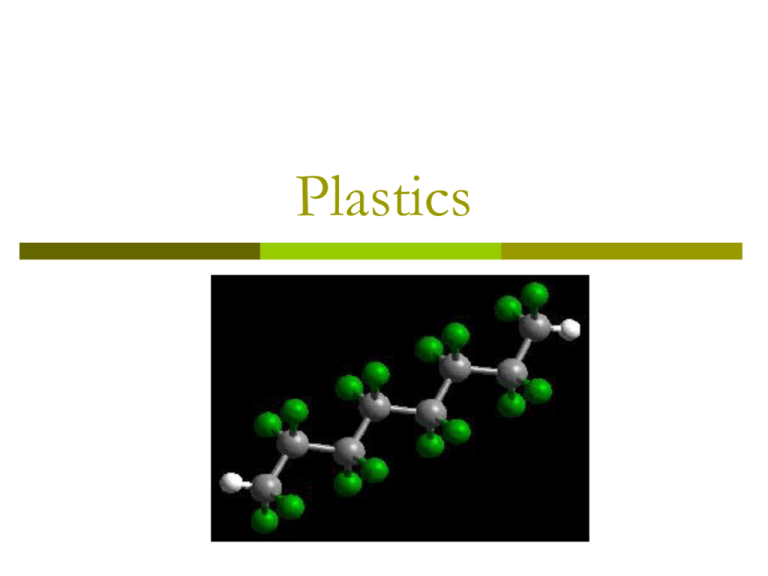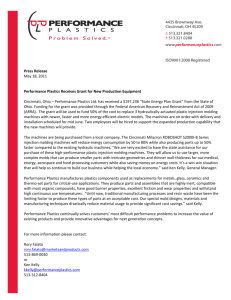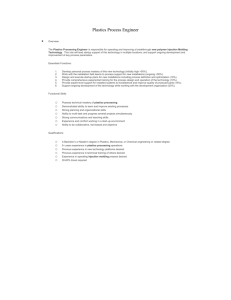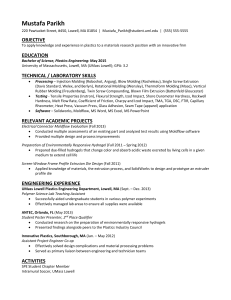Plastics
advertisement

Plastics Plastics Background Definition the term plastics, as it is commonly used today refers to a large group of synthetic materials which are made from a number of common substances such as coal, salt, oil, natural gas, cotton, wood, and water Simple chemicals are pulled from the material to produce monomers. Which are capable of reacting with one another, are produced. Monomers are then built up in a chainlike molecules called polymers Types of Plastics Developments have produce over 40 groups or families of plastics. Each with its own characteristics, such as light weight, heavy weight, heat-resistant, hard, soft, clear, or opaque. Two general classifications Thermoplastics Thermosetting plastics Thermoplastics Become soft when heated and hard when cooled, regardless of the number of times the process is repeated This is due to the fact that linear molecular chains can move together when heated and cooled. Types of plastics – acrylics, celluloses, polyethylene, polyvinyl chloride (PVC), polystryrene, polyallomers, polycarbonates, polyimide, polypropylene, polysulfone, phenylene oxide nylons, methyl pentenes, ionomer, fluroplastics, acetal and acrylonitrile butradiene styrene (ABS) Thermosetting plastics Are also chainlike in molecular structure but the curing and hardening process involves the formation of cross-links between molecules in adjacent chains. Resulting in complex chains that are no longer free to move. Types – alkyds, aminous (urea and melamine formaldehyde), diallylphthalate (DAP), epoxies, furan, phenolics, polyesters, polyurethane, and silicones Production of Plastics Process of uniting monomers to form polymers is known as polymerization Accomplished by either a condensation or an addition process Raw material can come in any of the following forms Granules Powder Beads Liquid resins Production of Plastics The raw material is then produced into the following forms Additions to plastics Sheets Films Tubing Rods Solid or semisolid shape Plasticizers – added for workability Fillers – are added to produce bulk Fibers – added for strength and durability Hardeners – added to induce setting Plastics products are formed by a number of methods – injection molding, blow molding, expandable bead molding, compression molding, transfer molding, rotational modeling, form modeling, extrusion thermoforming, laminating, casting, and calendaring Injection Molding Measured amounts of powder or granules are fed into the intake end of the heated barrel of a molding machine. And forced forwarded by a ram. Heated to temperatures of 300 to 650 c Pressure from 5000 to 40000 psi Thermoplastics and thermosets are used. Blow Molding Three processes Extrusion blow molding – an extruder produces a hollow tube called a parison which is captured between the two halves of a hollow mold. The mold is close and air is blown into the tube forcing it to expand. Injection blow molding – process is same except the tube (parison) is injected molded on a steel rod and the rod is removed prior to closing the mold Stretch blow molding – involves, stretching the parison in the axial direction before blowing. Polyethylene is typically used, but PVC, polystyrene, and polypropylene are also used. Bottles and water cans are typical shapes produced Expandable Bead Molding Process used to produce lightweight products of polystyrene foam Small granules together with a small amount of an expanding agent are placed in a rolling drum and steam heated Heat softens the granules and the expanding agent enlarges their size Cooled and transferred to a mold Again heated to 135 c and until they fused together Flotation equipment, shipping containers, rigid insulation are typical products Compression Molding Simplest form of molding A measured amount of powder is place in a heated mold then closed Heat and pressure are applied to the plastic material which melts and flows to all parts of the mold Transfer Molding Differs from compression molding in that in the transfer molding process the molding compound is liquefied outside the molding chamber Transfer to the mold under pressure There the forming and setting takes place Rotational Molding Used to form hollow units with complex shapes and heavy walls A pre measured amount of powder or liquid resin is placed in the bottom half of a cold mold and the mold is closed Mold is heated and rotated. Then allowed to cooled Form Molding Made by mixing an expanding agent with either granules or powder and then heating it Heat melts the plastic and causes the formation of a gas which expands the molten material into foamed structure Quickly cooled to set the material Insulation is made in this manner Extrusion Thermoforming Is used to produce materials which have a constant cross section Heat material is pushed through a die Laminating Bonding together a number of layers of materials to form a single sheet. Casting Liquid plastic are poured into molds and set Calendaring Form of extrusion Plastic material is fed to a pair of revolving rollers which extrude a thin film or sheet between them Properties of Plastics Transparency (acrylics, methyl pentenes, polycarbonates, ionomer, polysulfone) resistance to discoloration (acrylics) good resistance to weathering (acrylics, epoxy, silicone, polyvinyl chloride) good dimensional stability (fluoroplastics, polycarbonates, phenylene, oxide, polyvinyl chloride, urea, melamine) toughness (Cellulosics, ionomer, nylone, phenoxies, polycarbonates, polyethylene) high impact resistance (acrylics, ethyl cellulose, polypropylene, polyimide, polycarbonates) abrasion resistance (nylons, polyallomers, polyimide, polypropylene) low moisture absorption (fluoroplastics, phenylene oxide, polypropylene, diallyl phthalate, silicone) ductility (phenoxies, acrylics, nylons) good adhesive qualities (epoxy, phenolics, amino resins) good resistance to chemicals (nylons polyethylene, phenylene oxide, polypropylene, polysulfone, diallylphthalate) Additives for plastics not all properties of plastics are positive ones, additives are necessary to reinforce another property. Antioxidants antistatic agents coloring agents coupling agents Fillers reinforcing agents flame retardants foaming agents Lubricants Plasticizers Preservatives processing aids ultraviolet stabilizers Plastics in Construction Structural Applications For use in structural applications plastics need to be reinforced Glass fiber, jute, cotton, sisal, asbestos, and synthetic and metallic fibers are used Flat sheets – glazing Thermoformed shapes – roof shapes, curtain wall Glass fiber structural shapes – used where corrosion is a problem (like steel members) Plastic foam boards – decking, roofing Fabrics – balloons over a pool Foamed insulation – insulating materials Nonstructural applications resilient flooring – vinyl tile, vinyl-cushioned flooring, linoleum, cork tile, rubber flooring Non resilient flooring – plastic terrazzo – plastic topping – carpets – tufted carpet – woven carpet - loomed carpet – knitted carpet – needle punched carpet interior finishes – wall coverings moisture control – vapor barriers plastic pipe – pvc caulking and sealing compounds paints and varnishes lights and sunscreens adhesives material coatings






